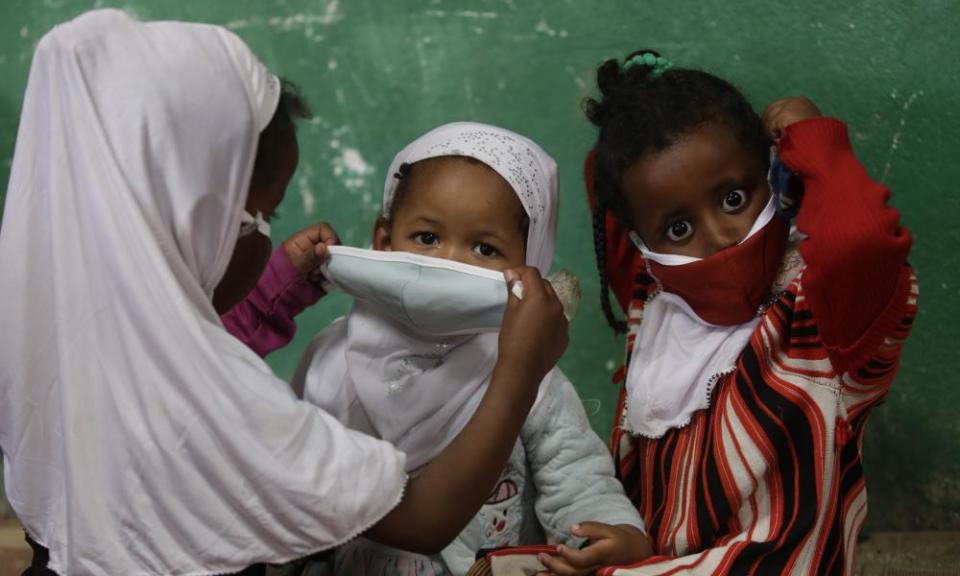Children half as likely to get coronavirus than adults, data shows

Children are about half as likely to become infected with coronavirus than adults, according to scientists who reviewed data gathered by contact tracing and population screening studies around the world.
The study, which will feed into the debate on when to open schools, found that children and young adults under the age of 20 appear 56% less likely to contract the virus than the over-20s, a finding that supports the idea that children are unlikely to play a major role in spreading the disease.
“It’s preliminary evidence, but the weight of evidence is clear that children appear to be less susceptible to Sars-Cov-2,” said Russell Viner, a professor of adolescent health at UCL Great Ormond Street Institute of Child Health and a senior author on the review.
The World Health Organization (WHO) guidance on face masks has remained consistent during the coronavirus pandemic. It has stuck to the line that masks are for healthcare workers – not the public.
“Wearing a medical mask is one of the prevention measures that can limit the spread of certain respiratory viral diseases, including Covid-19. However, the use of a mask alone is insufficient to provide an adequate level of protection, and other measures should also be adopted,” the WHO has stated.
Nevertheless, as some countries have eased lockdown conditions, they have been making it mandatory to wear face coverings outside, as a way of trying to inhibit spread of the virus. This is in the belief that the face covering will prevent people who cough and sneeze ejecting the virus any great distance.
There is no robust scientific evidence – in the form of trials – that ordinary masks block the virus from infecting people who wear them. There is also concerns the public will not understand how to use a mask properly, and may get infected if they come into contact with the virus when they take it off and then touch their faces.
Also underlying the WHO’s concerns is the shortage of high-quality protective masks for frontline healthcare workers.
Nevertheless, masks do have a role when used by people who are already infected. It is accepted that they can block transmission to other people. Given that many people with Covid-19 do not show any symptoms for the first days after they are infected, masks clearly have a potential role to play, especially on crowded public transport as people return to work..
Sarah Boseley Health editor
“The balance of evidence is clearly that children are the safest group to be out in the community. They have the lowest prevalence of infections and the risk of death or severe infection from Covid-19 is exceptionally low in children,” he said.
“So for children themselves, the balance of risk is strongly in favour of a return to school given the very clear evidence of harm due to lockdown.”
Researchers assessed more than 6,000 recent papers on the pandemic, most of which – like the review itself - have not yet been peer reviewed or formally published in journals, and whittled them down to 18 that contained useful data on children’s susceptibility to the virus.
Nine of the papers examined in further detail were contact tracing studies that followed infections from person to person. Eight reported virus and antibody test data and one was a review of studies on household clusters of infections.
One of the studies found that in 31 household clusters of Covid-19, only three could be traced back to a child as the person who brought the infection into the home.
Another report from Australia undertook contact tracing of all Covid-19 cases in schools in New South Wales over a six-week period from early March. It found that 18 index cases, comprising nine students and nine staff, gave rise to only two further cases among students and none among teachers, though children were being pulled from the schools at the time and awareness of the infection was high.
While the UCL-led review suggests that children are more resilient to the infection, the pooled data were not sufficient to confirm whether children spread the infection more or less easily than adults.
“In times of uncertainty, what we need to do is mitigate risks,” Viner said. “I would concur very strongly that an effective test and trace mechanism in place is very important to mitigate the uncertainty about transmission from children.”
Rosalind Eggo, a co-author on the review and an infectious disease modeller in public health epidemiology at the London School of Hygiene and Tropical Medicine, said the evidence suggested children and young people were at lower risk of infection than adults and “may therefore play a smaller role in the epidemic as a whole”.
She added: “This new evidence will help us better understand the possible effect of school reopening on transmission in schools and in the community.”
In a draft consultation published on Friday, a group of senior scientists warned that 1 June was too soon for schools to reopen safely and that more time was needed to set up an effective track and trace system to contain future outbreaks.
The Independent Sage committee, chaired by the former government chief scientist Sir David King, found the risk of children picking up the virus could be halved if they returned to school two weeks later than ministers were proposing. Delaying until September would reduce the risk still further, the report adds.

 Yahoo News
Yahoo News 